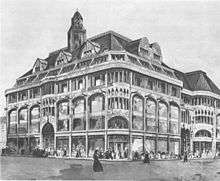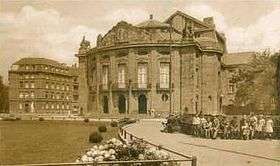Carl Moritz
| Carl Moritz | |
|---|---|
 Stollwerckhaus, Cologne (1906) | |
| Born |
27 April 1863 Berlin |
| Died |
23 August 1944 (aged 81) Berg |
| Alma mater | Technische Hochschule Charlottenburg |
| Occupation | Architect |

.jpg)
.jpg)
.jpg)

Carl Moritz (27 April 1863 – 23 August 1944) was a German architect and real-estate entrepreneur. Based in Cologne, he built the Cologne opera house of 1902, and various banks, theatres and churches in Germany.
Career
Born in Berlin, Moritz studied architecture at the Technische Hochschule Charlottenburg.[1] In 1894 he began his career as an independent architect in Berlin; the same year he took a study trip to England, one year later to Italy. From 1896 to 1898 he was inspector at the municipal building department in Cologne,[2] after which he worked there as a freelance architect. He founded eight architectural firms or companies in Cologne in the 1930s, working closely with the architects Albert Betten and Werner Stahl. In 1934 he retired and settled on Lake Starnberg, where he died in Berg, part of Starnberg.
A large part of his work involved bank building; during his career, Moritz designed about 40 banks, mostly for the Barmer Bank Corporation,[3] for whom he worked as a kind of house architect. About 50 houses and 15 housing estates by him are known. Moritz also planned twenty Catholic religious buildings and seven theatres, both construction tasks for which he can be considered a sought-after specialist. He was one of the developers of neo-Gothic architecture in Cologne.[4] He was very interested in the education of future generations, and during his career, held many lectures and wrote several publications.
Works
Moritz built theatres, including the opera house in Cologne in 1902, originally named the Stadttheater (Municipal Theatre).[5] It was destroyed in World War II, as was his Stadttheater Düren (1907).
Buildings still in use today include the Opernhaus Wuppertal (1905),[6] the Stralsund Theatre (1913),[7] the Stanisław Wyspianski Theatre, then "Neues Stadttheater" (New Municipal Theatre), in today's Katowice, and a baking factory that now hosts the Hans Peter Zimmer Art Foundation.[8][9] Church buildings include St. Joseph, Bielefeld (de) (1910) and the Erphokirche in Münster (1930).[10]
In Cologne, he built the Stollwerckhaus in 1906,[11] and the Gereonshaus in 1910.[12]
Publications
- "Die Entwicklung des modernen Theaterbaues." (Lecture at the convention of the Verband deutscher Architekten und Ingenieur-Vereine (VDAI) in Düsseldorf on 13 September 1904)
- In: Deutsche Bauzeitung, 1904
- In: Zentralblatt der Bauverwaltung, 1904, No. 77
- "Neue Theaterkultur. Vom modernen Theaterbau." (in Flugblätter für künstlerische Kultur) Stuttgart 1906.
- "Wohnhäuser und Villen von Carl Moritz, Architekt in Cöln." (in the second extra edition of the magazine Die Architektur des XX. Jahrhunderts.) Ernst Wasmuth, Berlin 1909.
- "Kirchliche Bauten und Klöster, Erziehungsanstalten und Krankenhäuser." (in the seventh extra edition of the magazine Die Architektur des XX. Jahrhunderts.) Ernst Wasmuth, Berlin 1910.
- "Banken und andere Verwaltungsgebäude." (in the ninth extra edition of the magazine Die Architektur des XX. Jahrhunderts.) Ernst Wasmuth, Berlin 1911.
References
- ↑ Konerding, Tünn; Herzogenrath, Wulf; Teuber, Dirk; Thiekötter, Angelika (1984). Der Westdeutsche Impuls 1900-1914: Kunst und Umweltgestaltung im Industriegebiet. Die Deutsche Werkbund-Ausstellung, Cöln 1914 (in German). Cologne: Kölnischer Kunstverein. p. 180. OCLC 256273800.
- ↑ Fraquelli, Sybille (2008). Im Schatten des Domes: Architektur der Neugotik in Köln 1815–1914. Atlas, N.F. (in German). 5. Cologne: Böhlau. p. 240. ISBN 9783412201623.
- ↑ Fussbroich, Helmut (1997). Architekturführer Köln: profane Architektur nach 1900 (in German). J.P. Bachem. p. 25. ISBN 978-3-7616-1305-4. Retrieved 17 July 2013.
- ↑ Fraquelli, p. 302.
- ↑ "Opernhaus am Rudolfplatz" (in German). bilderbuch-koeln.de. Retrieved 16 July 2013.
- ↑ "Opernhaus". Architektur Wuppertal (in German). Retrieved 3 July 2013.
- ↑ "Theater Vorpommern in Stralsund" (in German). Theater Vorpommern. Archived from the original on 6 August 2013. Retrieved 1 August 2013.
- ↑ "The Space". Hans Peter Zimmer Stiftung. Retrieved 16 July 2013.
- ↑ "The Stanisław Wyspianski Theatre". Lost Tribe Productions. Retrieved 16 July 2013.
- ↑ "Quartier der Gegensätze" (in German). Westfälische Nachrichten. 14 April 2008. Retrieved 1 August 2013.
- ↑ "Architektur des 20. Jahrhunderts : Das alte Stollwerck Haus". bilderbuch-koeln.de. Retrieved 1 August 2013.
- ↑ "Gereonshaus im Kölner Bankenviertel wird neues Domizil des Deutschen Städtetages und des Städtetages NRW". staedtetag.de. 1 February 2010. Retrieved 1 August 2013.
Footnotes
- Ralph Berndt: Bernhard Sehring. dissertation, TU Cottbus, 1998. (German)
- Klaus Winands: Das Theater in Stralsund. In: Denkmalschutz und Denkmalpflege in Mecklenburg-Vorpommern, volume 6 (1999) (German)
- Wolfram Hagspiel: Köln-Marienburg. Bauten und Architektur eines Villenvorortes. Bachem, Köln, 1996. (German)
- Wulf Herzogenrath: Der Westdeutsche Impuls 1900–1914. catalogue, Kölnischer Kunstverein 1984. (German)
External links
| Wikimedia Commons has media related to Carl Moritz. |
- Literature by and about Carl Moritz in the German National Library catalogue
- Teatr Slaski im. Stanislawa Wyspianskiego andreas-praefcke.de (German)
- Wohnhäuser und Villen von Carl Moritz Architekt in Cöln. (Architektur des XX. Jahrhunderts, 2. Sonderheft 1909) klinebooks.com (German)